Photocytotoxicity and photoinduced phosphine ligand exchange in a Ru(ii) polypyridyl complex
- PMID: 35308843
- PMCID: PMC8848995
- DOI: 10.1039/d1sc05647f
Photocytotoxicity and photoinduced phosphine ligand exchange in a Ru(ii) polypyridyl complex
Abstract
Two new tris-heteroleptic Ru(ii) complexes with triphenylphosphine (PPh3) coordination, cis-[Ru(phen)2(PPh3)(CH3CN)]2+ (1a, phen = 1,10-phenanthroline) and cis-[Ru(biq)(phen)(PPh3)(CH3CN)]2+ (2a, biq = 2,2'-biquinoline), were synthesized and characterized for photochemotherapeutic applications. Upon absorption of visible light, 1a exchanges a CH3CN ligand for a solvent water molecule. Surprisingly, the steady-state irradiation of 2a followed by electronic absorption and NMR spectroscopies reveals the photosubstitution of the PPh3 ligand. Phosphine photoinduced ligand exchange with visible light from a Ru(ii) polypyridyl complex has not previously been reported, and calculations reveal that it results from a trans-type influence in the excited state. Complexes 1a and 2a are not toxic against the triple negative breast cancer cell line MDA-MB-231 in the dark, but upon irradiation with blue light, the activity of both complexes increases by factors of >4.2 and 5.8, respectively. Experiments with PPh3 alone show that the phototoxicity observed for 2a does not arise from the released phosphine ligand, indicating the role of the photochemically generated ruthenium aqua complex on the biological activity. These complexes represent a new design motif for the selective release of PPh3 and CH3CN for use in photochemotherapy.
This journal is © The Royal Society of Chemistry.
Conflict of interest statement
The authors declare no competing financial interest.
Figures
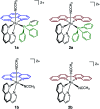

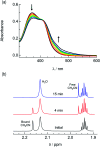
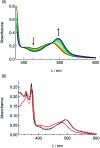
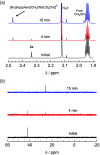
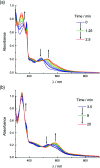



Similar articles
-
Selective photoinduced ligand exchange in a new tris-heteroleptic Ru(II) complex.J Phys Chem A. 2013 Dec 19;117(50):13885-92. doi: 10.1021/jp4085684. Epub 2013 Nov 5. J Phys Chem A. 2013. PMID: 24124931
-
New Ru(II) complexes for dual photoreactivity: ligand exchange and (1)O2 generation.Acc Chem Res. 2015 Aug 18;48(8):2280-7. doi: 10.1021/acs.accounts.5b00227. Epub 2015 Jul 17. Acc Chem Res. 2015. PMID: 26186416 Free PMC article.
-
Photoinduced ligand exchange and DNA binding of cis-[Ru(phpy)(phen)(CH3CN)2]+ with long wavelength visible light.J Inorg Biochem. 2013 Apr;121:77-87. doi: 10.1016/j.jinorgbio.2012.12.003. Epub 2012 Dec 16. J Inorg Biochem. 2013. PMID: 23353083
-
Steric and Electronic Factors Associated with the Photoinduced Ligand Exchange of Bidentate Ligands Coordinated to Ru(II).Photochem Photobiol. 2015 May-Jun;91(3):616-23. doi: 10.1111/php.12392. Epub 2014 Dec 23. Photochem Photobiol. 2015. PMID: 25403564
-
Critical Overview of the Use of Ru(II) Polypyridyl Complexes as Photosensitizers in One-Photon and Two-Photon Photodynamic Therapy.Acc Chem Res. 2017 Nov 21;50(11):2727-2736. doi: 10.1021/acs.accounts.7b00180. Epub 2017 Oct 23. Acc Chem Res. 2017. PMID: 29058879 Review.
Cited by
-
Triterpenes and Pheophorbides from Camellia ptilosperma and Their Cytotoxicity, Photocytotoxicity, and Photodynamic Antibacterial Activity.Molecules. 2023 Oct 12;28(20):7058. doi: 10.3390/molecules28207058. Molecules. 2023. PMID: 37894536 Free PMC article.
-
Computational Exploration of the Mechanism of Action of a Sorafenib-Containing Ruthenium Complex as an Anticancer Agent for Photoactivated Chemotherapy.Molecules. 2024 Sep 11;29(18):4298. doi: 10.3390/molecules29184298. Molecules. 2024. PMID: 39339293 Free PMC article.
-
Mutual Placement of Isocyanide and Phosphine Ligands in Platinum(II) Complexes [PtHal2L1L2] (Hal = Cl, Br, I; L1,L2 = CNCy, PPh3) Leads to Highly-Efficient Photocatalysts for Hydrosilylation of Alkynes.Molecules. 2023 Nov 24;28(23):7764. doi: 10.3390/molecules28237764. Molecules. 2023. PMID: 38067492 Free PMC article.
-
Photoactivatable Ruthenium Complexes Containing Minimal Straining Benzothiazolyl-1,2,3-triazole Chelators for Cancer Treatment.Inorg Chem. 2024 Apr 8;63(14):6202-6216. doi: 10.1021/acs.inorgchem.3c04432. Epub 2024 Feb 22. Inorg Chem. 2024. PMID: 38385171 Free PMC article.
-
Triarylphosphine-Coordinated Bipyridyl Ru(II) Complexes Induce Mitochondrial Dysfunction.Inorg Chem. 2023 Jul 17;62(28):10940-10954. doi: 10.1021/acs.inorgchem.3c00736. Epub 2023 Jul 5. Inorg Chem. 2023. PMID: 37405779 Free PMC article.
References
-
- Vittardi S. B. Magar R. T. Breen D. J. Rack J. J. J. Am. Chem. Soc. 2021;143:526–537. doi: 10.1021/jacs.0c08820. - DOI - PubMed
- King A. W. Wang L. Rack J. J. Acc. Chem. Res. 2015;48:1115–1122. doi: 10.1021/ar500396a. - DOI - PubMed
- McClure B. A. Mockus N. V. Butcher, Jr D. P. Lutterman D. A. Turro C. Petersen J. L. Rack J. J. Inorg. Chem. 2009;48:8084–8091. doi: 10.1021/ic900421v. - DOI - PubMed
-
- Karges J. Kuang S. Maschietto F. Blacque O. Ciofini I. Chao H. Gasser G. Nat. Commun. 2020;11:1–13. - PMC - PubMed
- Jakubaszek M. Goud B. Ferrari S. Gasser G. Chem. Commun. 2018;54:13040–13059. doi: 10.1039/C8CC05928D. - DOI - PubMed
- Mari C. Pierroz V. Ferrari S. Gasser G. Chem. Sci. 2015;6:2660–2686. doi: 10.1039/C4SC03759F. - DOI - PMC - PubMed
-
- White J. K. Schmehl R. H. Turro C. Inorg. Chim. Acta. 2017;454:7–20. doi: 10.1016/j.ica.2016.06.007. - DOI - PMC - PubMed
- Knoll J. D. Albani B. A. Turro C. Acc. Chem. Res. 2015;48:2280–2287. doi: 10.1021/acs.accounts.5b00227. - DOI - PMC - PubMed
- Knoll J. D. Turro C. Coord. Chem. Rev. 2015;282–283:110–126. doi: 10.1016/j.ccr.2014.05.018. - DOI - PMC - PubMed
- Sun Y. El Ojaimi M. Hammit R. Thummel R. P. Turro C. J. Phys. Chem. B. 2010;114:14664–14670. doi: 10.1021/jp102613n. - DOI - PubMed
LinkOut - more resources
Full Text Sources
Miscellaneous

